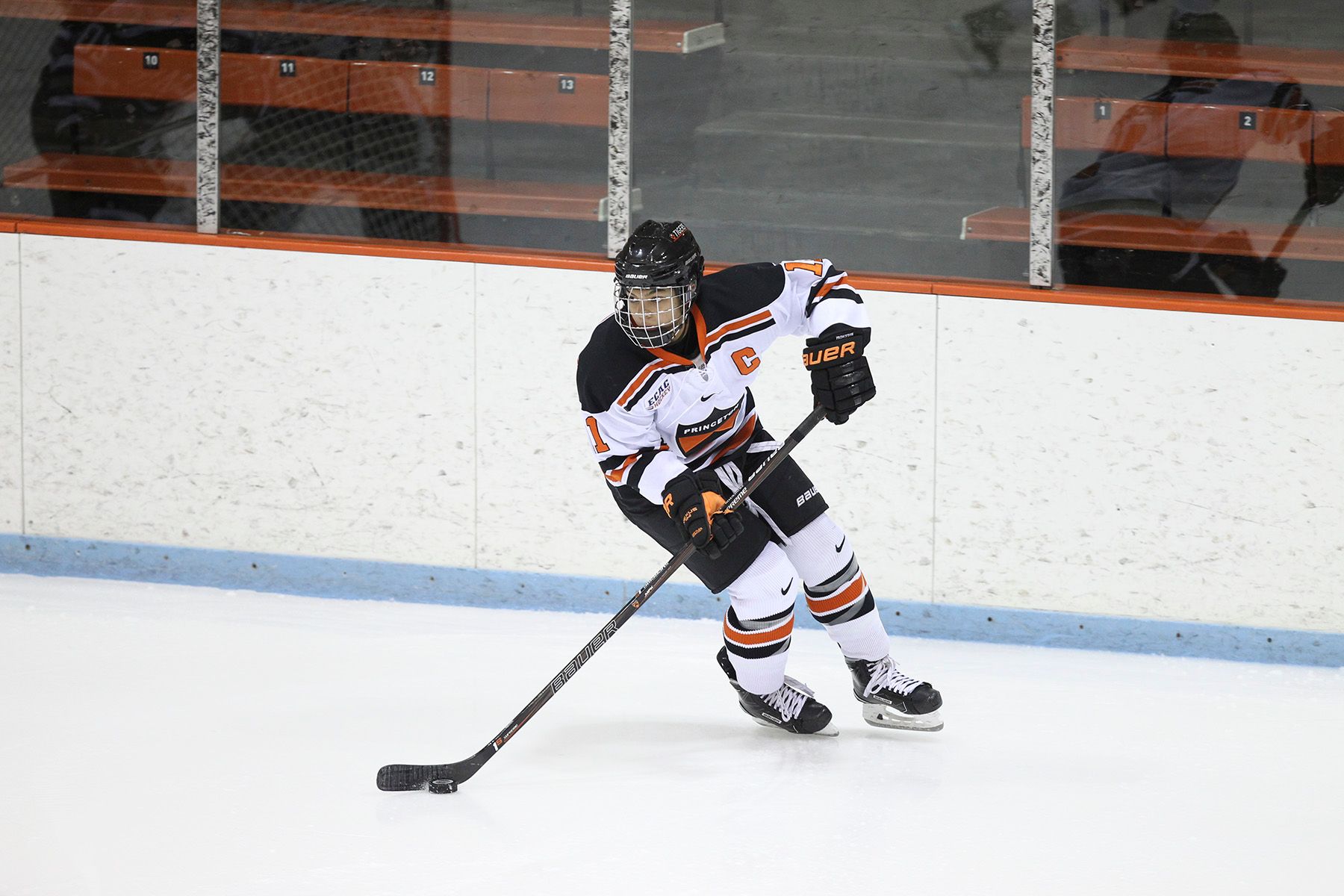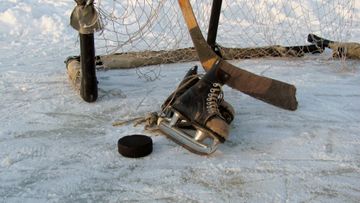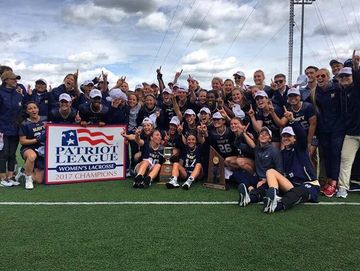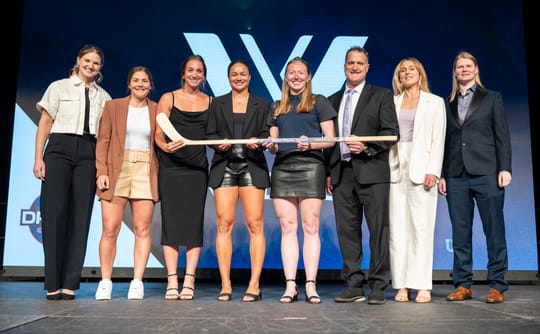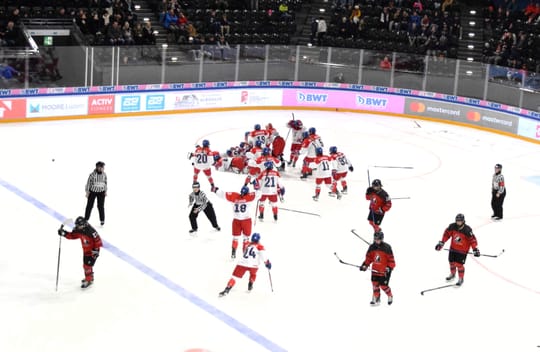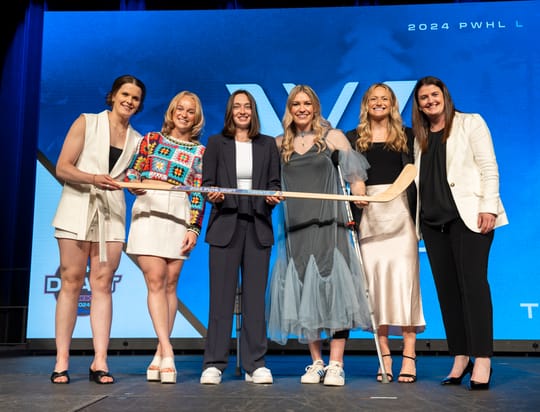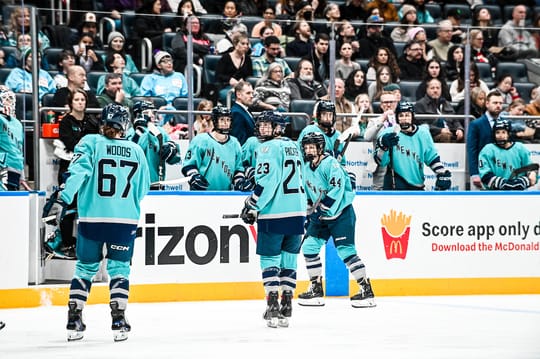PHOTO CREDIT: Beverly Schaefer/Courtesy of Princeton Athletics
This year marks the 45th anniversary of Title IX, the landmark legislation that has significantly improved the ability of girls and women to participate in sports. Their participation in college athletics has grown seven-fold in the past 45 years, according to a recently released excerpt from Title IX at 45, which was published by the National Coalition for Women and Girls in Education (1).
However, when looking at the impact of Title IX over the years, Dr. Moneque Walker Pickett, et al. noticed a startling trend (2). With the exception of basketball and track & field, women of color are underrepresented in college sports, despite the aforementioned overall growth. Girls and women are playing ice hockey in record numbers, but women of color are still an anomaly. As a companion to a media roundtable on racism in hockey, The Victory Press spoke to Meghan Huertas, Kaliya Johnson, Kelsey Koelzer, and Blake Bolden about playing a sport that lacks diversity.
The only one
Any female hockey player of a certain age was likely the only girl on at least one of her youth teams growing up. "I think I can count on one hand the number of players of color I've played against, or with, in my life," said Kelsey Koelzer in a phone interview. "I would definitely say, probably in my entire career, it's around ten total, which is a little crazy to think of, considering I've been playing hockey for eighteen years now."
Meghan Huertas, who graduated from the University of Minnesota-Duluth, has an interesting twist on her hockey experience. Huertas, whose father is originally from Cuba, grew up in Florida. Initially, it was her sport of choice, not her race, that made her stick out.
"When [my parents] first took me to a hockey game and I begged them to let me play, they were like, 'What do we do? Why, out of all the sports, [do] you wanna play this?'" she said. As she grew up in the sport, she quickly realized that neither Floridians nor those with Hispanic/Latino heritage were prominent in ice hockey.
Having "the talk"?
If you speak to the parents of black boys in America, "the talk" has nothing to do with sex. "The talk" is the time when the parents of a black boy must share the reality that society will criminalize their son, just for him existing. In one way or another, all the women we spoke with had a sports version of "the talk."
"I think I can, generally, only remember two instances which the N-word was pointed my way," said Koelzer, adding that both happened in her teen years while playing with boys. "The only instance in which my parents and my mom felt the need to talk to me about [race] or ask me how I feel about it was when I ran into an instance where a derogatory comment was made my way, which didn't happen frequently."
Blake Bolden also recalls having "the talk" with her mother. "She was the one that said, 'Okay, this is kinda what it's gonna be like, and if at any time you feel uncomfortable, you can always come to me.' She was the one talking to me about that stuff."
Bolden was introduced to hockey by a white man her mother dated when she was younger, who had a slightly different take: "He liked that I was the only black girl [laughs]...my dad was just like, 'screw those boys, screw those people.' I had a really good balance between the two."
Women seemed to have an unspoken agreement to remain united after surviving boys’ hockey. However, race and racism did penetrate the women's hockey sisterhood from time to time, mostly in the form of microaggressions.
Say what?
In the women's game, Huertas has often been misclassified. In college, until teammates and opponents found out otherwise, she was presumed to be African-American. Additionally, she has been called Mexican by people that knew her lineage, almost as a derogatory joke.
While Huertas is willing to let those things roll off her shoulders, she still wants to be known for who she is -- a Cuban-American.
However, that sometimes comes with cultural and even geographical lessons that can be ignorant and offensive.
"Some people are just uneducated, you know," said Huertas, "Some people think that people from Cuba speak Cuban...I've had some girls not even know where Cuba is on a map."
As Kaliya Johnson began playing hockey exclusively with girls, she too noticed more questions related to her race. "[L]ittle things like, 'Oh Kaliya, why aren't you washing your hair every day?', that sort of thing. Just stuff that typical African Americans go through." She didn't have a teammate with thicker hair who understood that daily washing would strip her hair of its natural oils, making it dry and unhealthy.
"I get a lot of the, 'Why don't you get a weave' thing, and I'm like, what? It's a little bit crazy, but, you know," she laughed. She didn't have another black teammate until she attended Boston College with Blake Bolden.
Is hockey for everyone?
The fastest growing sports for women -- soccer, lacrosse and ice hockey, to name a few -- are often unavailable for communities of color. Ice hockey is an expensive sport that is geographically isolated. Additionally, most elite female hockey players attend some type of boarding or prep school for the opportunity to play high level girls’ hockey.
"My high school didn't even have ice hockey down in Florida," said Huertas, who played hockey at the North American Hockey Academy during her high school years. NAHA is an accredited independent secondary school in Vermont that uses tutors to educate elite and developmental athletes.
Johnson also attended the Academy, but admitted that the expenses were something of a concern for her family.
"I have a brother and a sister and they were in high school, kind of on their way out...it was just a lot financially on my mom," she said.
Johnson was able to coordinate a payment plan that did not go into effect immediately. Her ability to focus on hockey at a place like NAHA led to a scholarship at BC. The gamble paid off for Johnson's family, as well as her alma mater. The arrangement speaks to the high stakes for academies or boarding schools in the landscape of women's ice hockey. While attending NAHA was not the only chance for Johnson to continue playing elite hockey, it was the overwhelmingly successful (even if assumed) route.
Bolden, who attended Northwood High School in Ohio, was again given "the talk." However, it was a decision that opened so many doors for her. "What was I going to be doing at home in Cleveland? Playing [with] boys, there's no female hockey coaches in collegiate hockey that are going to be able to see me." Bolden packed up and went to school in Lake Placid, New York, and earned a scholarship to play hockey at Boston College.
Koelzer opted for another route.
"From the time I switched over to girls hockey, there was this underlying pressure to go to a prep school," she said.
She would have none of it. After consulting with her coaches and family, she decided to work hard and stay at home. Koelzer played for her high school’s boys’ team, as well as a girls' traveling team, the New Jersey Rockets. Admittedly, the decision to play locally was informed by her desire to want to play hockey at an Ivy League school. Koelzer will graduate from Princeton next month.
Each woman had her own path and her own sacrifices to make en route to Division I hockey, and ultimately to the NWHL. However, it is clear that access and economics are a great divide when it comes to hockey.
See it to believe it
Johnson latched on to Bolden as her big sister, a partner in crime for what had always been an isolated path.
"[I]t was like a huge deal for me to have someone to look up to and who was older than me and just, someone who was looking out for me in college," she said. "Everyone called me her little sister, we were like Diva 1, Diva 2 -- it was kinda like a running joke ‘cause I would just follow her around everywhere. My mom tells me now that she'd always apologize to Blake like, 'I know you didn't ask for this, but she looks up to you.'
"I was probably attached to her hip way more than I should have been. But she was very good about it."
Today, Johnson willingly looks to be the Blake to someone else's Kaliya. Her mom always did -- and still does -- urge her daughter to be a role model.
"[She] tried to push on me the fact that I'm in a unique position...I can be someone who can help others follow their dreams, whether it's in hockey or in other sports that they're not necessarily the majority in their sport," she said. Luckily, programs such as Ice Hockey in Harlem, Snider Hockey, and SCORE Boston all exist to narrow the access gap for ice hockey.
Deniere Watford-Jackson is a volunteer and a hockey mom of the SCORE Boston program. She initially got involved to give her two daughters another activity during the soccer offseason.
"We tried it five years ago, and they're still there and still loving it," said Watford-Jackson in a phone interview.
The SCORE program mainly aims to introduce inner-city youth to hockey. The coed environment involves a learn-to-skate program, as well as recreation league teams. Some children, including Watford-Jackson's daughters, go on to more competitive teams from SCORE. When they do, the under-representation in the sport is still apparent. Deniere and her husband definitely have had "the talk" with their daughters, but her children had a much different introduction to hockey than any of the NWHL players we spoke to. The girls grew up playing with both boys and girls, of whom 51 percent are children of color.
To see other black hockey players, especially professional female players, is a huge thrill.
"We're currently trying to build relationships, in particular with female athletes," Whitford-Jackson said. As a board member of SCORE, and a hockey mom, she has firsthand experience with the benefits of children watching a professional athlete that looks like them.
Shortly before our interview last month, Bolden reached out to SCORE, and Deniere could not wait to share the news with her daughters: "I actually woke them up when I got the email from Blake Bolden and they were screaming." The girls have also scheduled private lessons with Blake Bolden Athletics, and look forward to being able to speak with the newest member of HC Lugano about hockey in person.
A few girls from our Bantams here for @SportBlake Skills sessions at Pilgrim Arena, Hingham #Intense but they're learning from the best 💪🏾
— SCORE BOSTON HOCKEY (@scoreboshockey) May 7, 2017
The opportunity to interact with a female professional hockey player of color was not something any current NWHL player had much access to, with the exception of Julie Chu, a Chinese-American/Puerto Rican veteran of USA Hockey.
Chu is not the first or the last woman of color to play ice hockey. But stories of players like Angela James, Kelly Babstock, Cherie Stewart, and Kourtney Kunichika are limited.
"Showing that there is a significant lack in... people of color playing this game -- which is predominantly white, which it's always just been that way -- I think it's something that's important to be talked about," said Johnson.
Speak about it
Although it can be tiring to constantly be asked about the lack of diversity in hockey, all the women understand the importance of having more conversations about race and access to ice hockey. "You're calling me to talk about being an African-American because I'm African-American," said Bolden. "Most of the time when people want to speak to me in media relations, it's eight times out of ten for that reason."
Before we revert to our "post-racial" society, let's think about what we ask players of color, and why? Is it just to discuss being left off a national team roster? Are there times when we can (and should) ask about the experiences of athletes without provocation? For Bolden, she welcomes being an advocate for more diversity in hockey, and accepts her oft-given title as a trailblazer; but she wants people to remember why she's being asked about diversity in sport in the first place.
"I am a hockey player," she said.
With that said, Bolden will always answer questions about race, because she didn't have the luxury of reading interviews about black female hockey players as a child.
Huertas also welcomes thoughtful questions that allow her to share her culture. "I wouldn't mind someone asking me what [ethnicity] I am... I'm proud to be Hispanic, especially Cuban." The opportunity to share her culture might drive home the point that people from her background don't play ice hockey. She's already done so for her family, who now consider themselves to be hockey fans.
However, it will take more than these four women -- or the other women of color in the NWHL -- talking about race. As we saw with the U.S. Women's national team, the hockey community must truly #BeBoldForChange. More investment in girls’ hockey was included in the latest contract with the national team and USA Hockey.
When we asked Johnson what such an improvement could mean for girls of color, she responded, "I'm not really sure if that was ever thought about in terms of [that] when they were addressing this issue, because it's not something that they personally have to deal with."
Although Koelzer was invited to the most recent USA Hockey camp, she was not selected to the most recent 23-player roster ahead of the 2018 Winter Olympics. There are no black women on Team USA, nor any who identify as women of color. Yet Johnson remains hopeful while also remaining observant of the current reality.
"I'm hoping it opens more opportunities for all girls, especially girls of color...At the end of the day, if the talent is there, you should be given the opportunity to compete, just like everybody else," she said. "But unfortunately, that's just not how the cookie crumbles all the time."
1. "Title IX and Athletics". Early release excerpt from Title IX at 45. National Girls & Women of Color in Education. February 1, 2017. http://www.ncwge.org/TitleIX45/Title%20IX%20and%20Athletics.pdf
2. Pickett, Moneque Walker, Dawkins, Marvin, Braddock, Jomills, II. May 2009. The effect of Title IX on participation of black and white females in high school sports: Evidence from national longitudinal surveys. Journal of Race and Policy. 5, (1), 79-90.
Primary editing on this piece was done by Angelica Rodriguez.
